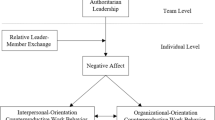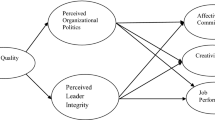Abstract
The aim of the study is to explore that whether Leader-Member Exchange (LMX) and agreeableness incite an employee to create façade of conformity (FOC) and how creation of FOC affects employee’s emotional exhaustion considering moderating effects of trust in management and employee’s emotional stability amongst four service sector organizations of Islamabad, Pakistan. Data Analysis of 303 supervisor-subordinate dyads using OLS regression found that LMX is negatively and significantly related to FOC while agreeableness is positively and significantly related to FOC. Effects of LMX on FOC are moderated by employee’s trust in management. Effect of FOC was lower among those having high degree of trust in management as compared to those who have lower degree of trust in management. FOC leads to emotional exhaustion. Moreover, effects of FOC on emotional exhaustion are moderated by employee’s emotional stability. Such that the effect of emotional exhaustion seems to be lower among those who have higher levels of emotional stability. No evidence was found that LMX and agreeableness directly affects emotional exhaustion without their effect on FOC. Based on these findings, we have discussed practical implications for managers along with limitations of the study and future directions.



Similar content being viewed by others
Change history
04 May 2017
An erratum to this article has been published.
References
Anderson, J. C., & Gerbing, D. W. (1988). Structural equation modeling in practice: a review and recommended two-step approach. Psychological Bulletin, 103(3), 411.
Ashkanasy, N. M., & O’Connor, C. (1997). Value congruence in leader–member exchange. Journal of Social Psychology, 137, 647–662.
Ashton, M. C., & Lee, K. (2009). The Hexaco-60: a short measure of the major dimensions of personality. Journal of Personality Assessment, 91(4), 340–345.
Botero, I. C., & Van Dyne, L. (2009). Employee voice behavior: interactive effects of LMX and power distance in the United States and Colombia. Management Communication Quarterly, 23(1), 84–104.
Brief, A., Buttram, R., & Dukerich, J. (2001). Collective corruption in the corporate world: Toward a process model (Vol. 471). Mahwah: Lawrence Erlbaum.
Brown, L. M., Christensen, J. J., Ialynytchev, A., Thomas, K. S., Frahm, K. A., & Hyer, K. (2015). Experiences of assisted living facility staff in evacuating and sheltering residents during hurricanes. Current Psychology, 34(3), 506–514.
Cook, J., & Wall, T. D. (1980). New work attitude measures of trust, organizational commitment, and personal need non-fulfillment. Journal of Occupational Psychology, 53, 39–52.
Cordes, C. L., & Dougherty, T. W. (1993). A review and an integration of research on job burnout. Academy of Management Review, 18, 621–656.
Cordes, C. L., Dougherty, T. W., & Blum, M. (1997). Patterns of burnout among managers and professionals: a comparison of models. Journal of Organizational Behavior, 18, 685–701.
Demerouti, E., Bakker, A. B., Nachreiner, F., & Schaufeli, W. B. (2001). The job demands resource model of burnout. Journal of Applied Psychology, 86, 499–512.
Dirks, K. T., & Ferrin, D. L. (2001). The role of trust in organizational settings. Organization Science, 12(4), 450–467.
Duffy, M. K., Scott, K. L., Shaw, J. D., Tepper, B. J., & Aquino, K. (2012). Why and when envy leads to social undermining: development and tests of a social context framework. Academy of Management Journal, 55, 643–666.
Dulebohn, J. H., Brouer, R. L., Bommer, W. H., Ferris, G. R., & Kato, K. (2008). A meta-analysis of the antecedents of leadermember exchange: integrating the past with an eye toward the future [Working paper]. East Lansing: Michigan State University.
Edwards, J. R., Caplan, R. D., Harrison, R. V., & Cooper, C. L. (1998). Person-environment fit theory: conceptual foundations, empirical evidence, and directions for future research. In C. L. Cooper (Ed.), Theories of organizational stress (pp. 28–67). Oxford: Oxford University Press.
Fenlason, K. J., & Beehr, T. A. (1994). Social support and occupational stress: effects of talkingto others. Journal of Organizational Behavior, 15, 157–175.
Goffman, E. (1959). The presentation of self in everyday life. Garden City: Doubleday.
Gomez, C., & Rosen, B. (2001). The leader–member exchange as a link between managerial trust and employee empowerment. Group & Organization Management, 26, 53–69.
Graen, G. (1976). Role-making processes within complex organizations. Handbook of Industrial and Organizational Psychology, 1201, 1245.
Graziano, W. G., Jensen-Campbell, L. A., & Hair, E. C. (1996). Perceiving interpersonal conflict and reacting to it: the case for agreeableness. Journal of Personality and Social Psychology, 70, 820–835.
Halbesleben, J. R. B., & Bowler, W. M. (2007). Emotional exhaustion and job performance: the mediating role of motivation. Journal of Applied Psychology, 92(1), 93–106.
Hayes, A. F. (2012). Process: a versatile computational tool for observed variable mediation, moderation, and conditional process modeling.
Hayes, A. F. (2013). Introduction to mediation, moderation, and conditional processanalysis: a regression-based approach. New York: Guilford Press.
Hewlin, P. F. (2003). And the award for best actor goes to…: facades of conformity in organizational settings. Academy of Management Review, 28(4), 633–642.
Hewlin, P. F. (2009). Wearing the cloak: antecedents and consequences of creating facades of conformity. Journal of Applied Psychology, 94(3), 727.
Hobfoll, S. E. (1989). Conservation of resources: a new attempt at conceptualizing stress. American Psychologist, 44(3), 513.
Hobfoll, S. E. (2001). The influence of culture, community, and the nested-self in the stress process: advancing conservation of resources theory. Applied Psychology, 50(3), 337–421.
Hofstede, G. (1983). The cultural relativity of organizational practices and theories. Journal of International Business Studies, 14(2), 75–89.
Kacmar, K. M., Andrews, M. C., Harris, K. J., & Tepper, B. J. (2013). Ethical leadership and subordinate outcomes: the mediating role of organizational politics and the moderating role of political skill. Journal of Business Ethics, 115(1), 33–44.
Kassing, J. W. (2000). Investigating the relationship between superior-subordinate relationship quality and employee dissent. Communication Research Reports, 17(1), 58–69.
Kokkinos, C. M. (2007). Job stressors, personality and burnout in primary school teachers. British Journal of Educational Psychology, 77, 229–243.
Krone, K. J. (1991). Effects of leader-member exchange on subordinates' upward influence attempts. Communication Research Reports, 8(1), 9–18.
Lambert, L. S., Tepper, B. J., Carr, J. C, Holt, D. T., & Barelka, A. J. (2012). Forgotten, but not gone: an examination of fit between leader consideration and initiating structure needed and received. Journal of Applied Psychology, 97(5), 913–30.
Liden, R. C., & Maslyn, J. M. (1998). Multidimensionality of leader-member exchange: an empirical assessment through scale development. Journal of Management, 24(1), 43–72.
Lilly, J. D., & Wipawayangkool, K. (2017). Current Psychology. doi:10.1007/s12144-016-9555-7.
Maslach, C. A. (1982). Burnout: the cost of caring. Englewood Cliffs: Prentice Hall.
Maslach, C., & Jackson, S. (1981a). Maslach burnout inventory: MBI. Palo Alto: Consulting psychologists press.
Maslach, C., & Jackson, S. E. (1981b). The measurement of experienced burnout. Journal of Organizational Behavior, 2(2), 99–113.
Maslach, C., Schaufeli, W., & Leiter, M. (2001). Job burnout. Annual Review of Psychology, 52(1), 397–422.
Murphy, S. E., & Ensher, E. A. (1999). The effects of leader and substitute characteristics in the development of leader–member exchange quality. Journal of Applied Social Psychology, 29(7), 1371–1394.
Özyılmaz, A. (2012). Antecedents of Employee’s trust in supervisors, management, and organizations/Çalışanın Bir Üst Yöneticisine, Yönetime ve Organizasyona Duyduğu Güvenin Belirleyicileri. Mustafa Kemal Üniversitesi Sosyal Bilimler Enstitüsü Dergisi, 9(18).
Phillips, A. S., & Bedeian, A. G. (1994). Leader–follower exchange quality: the role of personal and interpersonal attributes. Academy of Management Journal, 37, 990–1001.
Piedmont, R. L. (1993). A longitudinal analysis of burnout in the health care setting: the role of personal dispositions. Journal of Personality Assessment, 61, 457–473.
Pilarska, A. (2016). Contributions of cognitive-motivational factors to the sense of identity. Current Psychology. doi:10.1007/s12144-016-9435.
Pilarska, A., & Suchańska, A. (2015). Self-complexity and self-concept differentiation – what have We been measuring for the past 30 Years? Current Psychology, 34, 723. doi:10.1007/s12144-014-9285-7.
Rokeach, M. (1973). The nature of human values (Vol. 438). New York: Free press.
Satchell, L., Morris, P., Akehurst, L., et al. (2017). Can judgments of threat reflect an approaching Person’s trait aggression? Current Psychology. doi:10.1007/s12144-016-9557-5.
Schaufeli, W. B., & Enzmann, D. (1998). The burnout companion to study and practice: a critical analysis. London: Taylor & Francis.
Sharma, C. S., & Sharma, N. (2014). Impact of facades of conformity on creativity and productivity - an investigation into coping strategies. Business Analyst, 35(1), 39–53.
Sharma, C. S., & Sharma, N. (2015). Impact of facades of conformity on self monitoring and emotional exhaustion – an investigation into its causes. Vidya International Journal of Management Research, 2(1), 38–44.
Sparrowe, R. T., & Liden, R. C. (1997). Process and structure in leader-member exchange. Academy of Management Review, 22(2), 522–552.
Spreitzer, G. M. (1996). Social structural characteristics of psychological empowerment. Academy of Management Journal, 39(2), 483–504.
Steiner, D. D. (1988). Value perceptions in leader-member exchange. The Journal of Social Psychology, 128(5), 611–618.
Storm, K., & Rothmann, S. (2003). The relationship between burnout, personality traits and coping strategies in a corporate pharmaceutical group. South African Journal of Industrial Psychology, 29, 35–42.
Stormer, F., & Devine, K. (2008). Acting at work façades of conformity in academia. Journal of Management Inquiry, 17(2), 112–134.
Teng, C., Chang, S., & Hsu, K. (2009). Emotional stability of nurses: impact on patient safety. Journal of Advanced Nursing, 65(10), 2088–2096.
Wat, D., & Shaffer, M. A. (2005). Equity and relationship quality influences on organizational citizenship behaviors: the mediating role of trust in the supervisor and empowerment. Personnel Review, 34(4), 406–422.
Xie, J., & Johns, G. (1995). Job scope and stress: can job scope be too high? Academy of Management Journal, 38, 1288–1309.
Zellars, K., & Perrewe, P. (2001). Affective personality and the content of emotional social support: coping in organizations. Journal of Applied Psychology, 86(3), 459–467.
Acknowledgements
The authors are highly grateful to the unknown referees for the valuable comments which prove highly useful to improve the quality of manuscript.
Author information
Authors and Affiliations
Corresponding author
Additional information
The original version of this article was revised: The name of the first author was written incorrectly as 'Fraz Ahmed'. It should have been 'Fraz Akbar'.
Practitioner Points
1) Study will facilitate managers to adopt such practices, which can refrain employees from façade creation.
2) Practitioners will find ways to curtail detrimental effects of FOC after its occurrence.
3) Organization will get benefit of P-O fit after avoiding façade creation.
Rights and permissions
About this article
Cite this article
Akbar, F., Akhtar, S. Relationship of LMX and Agreeableness with Emotional Exhaustion: a Mediated Moderated Model. Curr Psychol 37, 862–874 (2018). https://doi.org/10.1007/s12144-017-9566-z
Published:
Issue Date:
DOI: https://doi.org/10.1007/s12144-017-9566-z




